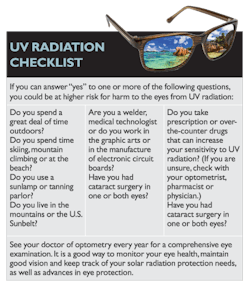Most of us have heard the warnings about the relationship between sun and UV light exposure and skin cancer. But many are not aware of how damaging sun and UV light can be to our eyes.
"Although not every situation or every person requires sunglasses, there are many situations where the use of sunglasses will enhance comfort and may provide eye health benefits as well," says Jessica Ciralsky, M.D., an attending ophthalmologist at NewYork-Presbyterian Hospital/Weill Cornell Medical Center.
While many of us think about the sun and tanning beds when we hear about ultraviolet (UV) radiation, other sources, such as welding operations and lasers, also can produce UV radiation. UV radiation can harm the eyes, and other components of solar radiation also can impact vision.
How to Protect the Eyes
There are three types of UV radiation. UV-C is absorbed by the ozone layer and does not present any threat. However, UV-A and UV-B radiation can have long- and short-term negative effects on the eyes and vision.
The longer the eyes are exposed to solar radiation, the greater the risk of developing cataracts or macular degeneration later in life. The American Optometric Association (AOA; http://www.aoa.org) recommends that whenever you spend time outdoors for work or play, wear quality sunglasses that offer UV protection and a hat or cap with a wide brim.
Sunglasses – AOA recommends the use of sunglasses that block 99-100 percent of UV-A and UV-B rays to protect the eyes from this radiation. Keep in mind that many sunglasses styles do not protect the eyes from the solar radiation entering from the sides or around sunglasses. To provide adequate protection for your eyes, AOA recommends sunglasses should:
- Block out 99 to 100 percent of both UV-A and UV-B radiation;
- Screen out 75 to 90 percent of visible light;
- Have lenses that are perfectly matched in color and free of distortion and imperfection; and
- Have lenses that are gray for proper color recognition.
- Wear impact-resistant lenses that meet ANSI Z87.1 if you are working outdoors where eye hazards such as flying wood chips or gravel could be an issue and when playing an outdoor sport.
Consider wearing wraparound frames for additional protection from harmful solar radiation if you spend a lot of time outdoors in bright sunlight.
Contact lenses – Some contact lenses offer additional protection. These contact lenses absorb UV radiation by reducing the amount of radiation that reaches the surface of eye. The contact lenses also protect the eye from the radiation that comes from above or around the sides of sunglasses.
The U.S. Food and Drug Administration has standards for UV-blocking contact lenses based on American National Standards Institute Z80.20 standards. There are two classifications of UV-blocking lenses:
FDA Class I blocker – Recommended for high-exposure environments such as mountains or beaches. The lenses in this classification must block more than 90 percent of UVA (316-380 nm wavelengths) and 99 percent of UVB (280 – 315 nm).
FDA Class II blocker – Recommended for general purposes. These lenses must block more than 70 percent of UVA and 95 percent of UVB.
Five-Point Checklist
"There are strong indications that chronic exposure to the components of sunlight may accelerate aging of ocular tissues," says Stephen Trokel, an attending ophthalmologist at New York-Presbyterian Hospital/Columbia University Medical Center, vice chair of CUMC's Department of Ophthalmology and director of the Columbia Vision Correction Center. "Any protective eyewear should also include side shield protection or wrap around the eyes to prevent light from entering from the side."
Ciralsky and Trokel offer a five-point checklist to help you choose the best sun protection for your eyes during the summer and all year round:
✔ Check the UV protection level. UV protection (protection from ultraviolet rays) is desirable year round; also, sunglasses should be worn during daylight hours even when the weather is cloudy or hazy. Your sunglasses should provide more than 95 percent UV protection.
✔ Check the lens tint. Most people believe that darker sunglasses provide better protection, but that is not necessarily the case. The lens tint should block 80 percent of transmissible light (light that can be transmitted through the lens), but no more than about 90 percent of light, or it will be hard for you to see. Neutral gray, amber, brown and green are good colors to choose from.
✔ Wear sunglasses over your contact lenses. People who wear contact lenses that offer UV protection should still wear sunglasses. Sunglasses help prevent the drying effect most contact lens-wearers experience, which is caused by warm wind.
✔ Buy sunglasses for your children. Consider buying sunglasses with UV protection for your children, and remember that the eyes of small infants should always be shaded from direct exposure to the sun.
Finally, a study found that Americans spend nearly 2.5 hours on their tablets and smartphones every day. In addition, most offices and stores use fluorescent light bulbs, and LED lights are becoming increasingly popular.
Lenses that absorb harmful blue light but allow beneficial blue light through your lenses are entering the marketplace. You also can apply a special clear coating to traditional lenses to enhance their ability to block these harmful rays while you use computers and smartphones.
Think Before You Buy
Your sunglasses might look "cool," but are they really that hot? According to the AOA's 2015 American Eye-Q® survey, 47 percent of consumers do not check the UV protection level before purchasing sunglasses.
If the eyes are unprotected and exposed to excessive amounts of UV radiation over a short period of time, even just a few hours, individuals may experience photokeratitis (sunburn to the cornea), pterygium (tissue growth on the whites of eyes that can block vision) and skin cancer on the eyelids. It also has been implicated in the development of cataracts and possibly macular degeneration, according to the AOA.
"Photokeratitis may be painful and include symptoms such as red eyes, a foreign-body sensation or gritty feeling in the eyes, extreme sensitivity to light and excessive tearing," says Karl Citek, O.D., Ph.D., chair of the AOA Commission on Ophthalmic Standards, who noted the discomfort generally is temporary and rarely causes permanent damage to the eyes.
Long-term overexposure to UV radiation over the course of a lifetime is a different matter, according to AOA. Long-term damage to the eye can result in cataracts, age-related macular degeneration, pterygium (an abnormal growth of the white of the eye onto the cornea, or clear window at the front of the eye) and cancer of the eyelids, skin around the eye and even the eye itself.
Kids often spend more time outdoors than adults, so parents need to be sure their children have appropriate eye protection. Unlike the lens found in an adult eye, which is more mature, a child's lens cannot filter out UV rays as easily, possibly causing damage to the retina.
"UV protection is important for people of all ages, but children's eyes are more vulnerable since they are more transparent than an adult's eyes," says Citek. "When children go to play outside, they are excited and may not remember to put on sunglasses. Parents can help get their kids in the habit of wearing their sunglasses, which will help instill good eye care practices for life."
About the Author

Sandy Smith
Sandy Smith is the former content director of EHS Today, and is currently the EHSQ content & community lead at Intelex Technologies Inc. She has written about occupational safety and health and environmental issues since 1990.

